 |
|||||
| The Lighthouse News and History Magazine | |||||
|
The Doomsday List - America's Most Endangered Lighthouses
In this composite photo, the remains of the Minnesota Point Lighthouse overlay an original photograph from the Lighthouse Digest archives. By Timothy Harrison The Doomsday List was created by Lighthouse Digest in 1993 in an effort to draw public attention to lighthouses that were endangered of being lost forever. Unfortunately, since that list was created, some lighthouses, such as the West Rigolets Lighthouse in Louisiana, the Galveston Jetty Lighthouse in Texas, the Chandeleur Island Lighthouse in Louisiana, the Cedar Point Lighthouse in Maryland, the Sabine Bank Lighthouse in Louisiana, and the Kauhola Point Lighthouse in Hawaii, all of which were on Doomsday List, were indeed destroyed and are now lost forever. However, in the case of Sabine Bank Lighthouse, the lantern room was saved. We have also removed Green Island Lighthouse in Wisconsin and Green Island Lighthouse in Ohio from the Doomsday List. Both structures are so far gone and remote that to bring them back would require a total rebuilding, which is highly unlikely to ever happen, especially at Green Island Lighthouse in Ohio where access by humans is restricted. Other lighthouses that were on the Doomsday List and were also destroyed, such as the Cape St. George Lighthouse in Florida and the Mispillion Lighthouse in Delaware, were rebuilt; however they are not entirely made of the original materials and were not rebuilt at their original locations. However, the accomplishment made in the rebuilding of Cape St. George Lighthouse is nothing short of a miracle. Additionally, thanks to some very dedicated people, Round Island Lighthouse in Mississippi, which was toppled by a hurricane, will now be rebuilt at a new location Since we first started the Doomsday List, there have also been some great success stories of lighthouses that have been saved and removed from the Doomsday List, such as Cape Hatteras Lighthouse in North Carolina; Southeast Lighthouse on Block Island, Rhode Island; Nauset Lighthouse on Cape Cod, Massachusetts; and Sankaty Lighthouse on Nantucket Island, which all faced a threat of collapse due to erosion. Thankfully, they were all saved when they were moved to safer locations. Other success stories of lighthouses once on the Doomsday List include Avery Point Lighthouse in Connecticut, Little River Lighthouse in Maine, Crisp Point Lighthouse in Michigan, Prospect Harbor Lighthouse in Maine, Isles of Shoals in New Hampshire, Dutch Island Lighthouse in Rhode Island, Point (Punta) Figuras Lighthouse in Puerto Rico, Grand Island East Channel Lighthouse in Michigan, and Clark's Point in Massachusetts, which have all been saved thanks to the efforts of dedicated volunteers who not only raised most of the money, but also did large portions of the restoration work. On the other hand Raspberry Island Lighthouse in the Apostle Islands of Wisconsin was saved from erosion by federal funds and additional federal money is also being used to now restore the other lighthouses of the Apostle Islands, as well as Monomoy Point Lighthouse in Massachusetts and the famous Bodie Island on the Outer Banks of North Carolina. Some endangered lighthouses that were on the Doomsday List, such as Gull Rock Lighthouse and Manitou Island Lighthouses, both in Michigan, and Plum Island Lighthouse and Pilot Island lighthouses in Wisconsin, have seen significant help in recent years and are in the process of being saved by dedicated volunteers and although there is much to still be done, we decided to no longer include them on the list. However, there are still a number of lighthouses in the United States that are on the Doomsday List, all for a variety of different reasons. Some of the lighthouses on the Doomsday List are so remote or so far gone, that short of a miracle, they may never be saved. In many cases lighthouses have been lost or will soon be lost because of outright government interference. This includes some lighthouses located in wildlife preserves or refuges such as Green Island Lighthouse in Ohio, where humans are not allowed, or where the government believes that restoration would disturb wildlife. Other examples of that could include West Sister Island Lighthouse in Ohio and Destruction Island Lighthouse in Washington, where, without the proper maintenance, these lighthouses will soon deteriorate. In other cases, historic preservation restoration guidelines are so off base and beyond reality that it would make restoration beyond the financial capabilities of most, other than perhaps the wealthiest people in the world. There are some who may claim that a lighthouse being considered endangered is actually nothing more than one's personal opinion and others would say that some lighthouses, in fair condition and now being restored, should also be on the endangered list until they are fully saved. There is also some question whether Florida's Reef Lighthouse should be added to the list, especially Florida's Sand Key Lighthouse, but for the time being we have not included them. Naturally, we welcome all comments and suggestions about the Doomsday List and we will update and modify it as conditions change or when new and updated information is received. However, a lighthouse can only be saved when people are made aware of the problem and then get involved. But, in nearly each and every situation, it will take one or two people to take the lead to get others motivated, while also understanding that lighthouse restoration is a long and arduous task. Plus, once a lighthouse is saved, it still needs the help of people to maintain the structure so that it will never again be on the brink of being lost. Over the years, Lighthouse Digest has played a significant role in various ways in helping to save many of these lighthouses, such as through stories in the pages of this magazine that have drawn public attention to their plight, which in turn inspired others to become involved, either as a volunteer or through donations. But much of this would not have happened without the loyal support of our many subscribers, whose paid subscriptions allow us to continue to draw public attention to saving the actual lighthouses themselves, and, just as importantly, saving and recording the history associated with them and all other lighthouses, especially those without a preservation group. Following are brief descriptions and photos of the some of the Doomsday List of Endangered Lighthouses. The entire list can be seen here 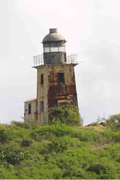 Buck Island Lighthouse Located on Buck Island, about two miles off the coast of St. Thomas in the U S Virgin Islands, this lighthouse was built in 1913 by the government of Denmark and was conveyed to the United States in 1919. Abandoned by the United States Coast Guard, the light was replaced by a skeleton tower. The lighthouse is now part of the Buck Island National Wildlife Refuge, where wildlife is more important than historic preservation and it is doubtful that this lighthouse will be restored.  Cedar Island Lighthouse Located in Gardiners Bay in eastern Long Island Sound near Sag Harbor, New York, this structure was built in 1864 to replace an earlier lighthouse. The lighthouse served until it was sold into private ownership in 1934. In 1967 the lighthouse was acquired by Suffolk County. However, in the early 1970s a devastating fire cause severe damage to the interior and roof, which was later replaced. Over the years, volunteers have done some work at the lighthouse, such as saving the oil house, but it will take an immense amount of resources and time to complete restoration. Although volunteers are working to raise public awareness and money, restoration is a long way off. However, as long as the interest remains strong, the prognosis for saving this lighthouse is good. 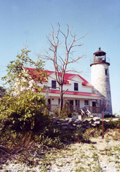 Charity Island Lighthouse Located on Big Charity Island in Lake Huron at the approach to inner Saginaw Bay in Michigan, the 1857 tower has suffered from neglect since it was discontinued in 1939. The old keeper's house was torn down by the private owners and replaced with a modern structure. The lantern and tower windows are all broken out, allowing water to enter and run down the interior walls, causing the spiral stairs to become loose, and brick and mortar is coming loose on the tower. Over the years there has been a lot of attention to saving the tower, but none of the efforts materialized. However, with the right partnership, this tower can still be saved.  Culebrita Island Lighthouse Built by Spain in 1886 in Culebra, Puerto Rico, ownership of the lighthouse was transferred to the United States after the Spanish-American War. It remained an active aid to navigation until the 1950s when it was abandoned. Although it was used for a while as a Naval observation tower, no repairs were ever made. In 1982 it was declared a National Historical Monument and although money was allocated, nothing was ever done. The structure is now on the verge of imminent collapse and it is highly unlikely that it can be saved.  The dome of the lantern room of Culebrita Lighthouse has been lying on the ground for years.  Destruction Island Lighthouse Built in 1891 on an island off the Olympic Peninsula near Kalaloch, Washington, the lighthouse was deactivated in 2008. The island is now under the control of the U.S. Fish and Wildlife Service as part of the Quillayute Needles National Wildlife Refuge and is off limits to the public. Without proper maintenance and care, the lighthouse and all the buildings will soon fall into a state of disrepair.  Fishing Battery Lighthouse Despite a number of attempts over the years to start efforts to save the Fishing Battery Lighthouse, none of them ever materialized. The 1853 structure, located at the mouth of Susquehanna River in the Upper Chesapeake Bay near Havre de Grace, Maryland, was discontinued in 1921 when it was replaced by a light on a steel tower. Many websites indicate that the lighthouse is part of a National Wildlife Refuge, however wildlife officials told us that the lighthouse is still owned by the Coast Guard. Reports indicate that the building is structurally sound. Because it would take a group with a lot of financial backing to restore the Fishing Battery Lighthouse, we believe the prognosis for saving this lighthouse is poor. 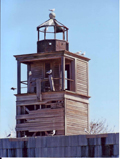 Fort Carroll Lighthouse Built on a manmade island near the mouth of the Patapsco River in Baltimore, Maryland, this structure was built in 1898 to replace an earlier tower. In 1958 the island went into private ownership, and over the years there were many plans to develop the island and restore the lighthouse, but none of the plans ever materialized. Interestingly, when Fort Carroll was completed, it was named and dedicated to Charles Carroll, who, at that time, was the only surviving signer of the Declaration of Independence. Today the lighthouse is in ruins and the prognoses for it being saved are slim to none. Before long, the lighthouse, like the name of Charles Carroll, will slip away into the pages of time.  Fourteen Mile Point Lighthouse Built in 1894, this was once one of Michigan's magnificent lighthouse stations. Located on the Keweenaw Peninsula near Ontonagon, the lighthouse was abandoned by the Coast Guard in the late 1940s. In 1984, mindless vandals maliciously set fire to the remote station, causing immense damage that destroyed the interior and the roof, leaving only a gutted out shell. In the 1990s it was purchased by individuals with hopes of restoring it. The new owners were dedicated to saving the light station; however, because of its remote location, it has since been realized that their dreams of seeing the lighthouse restored, although not impossible, are extremely improbable. The nearly 50 acre site with 4,000 feet of shoreline is now for sale.  Guanica Lighthouse Built by the Spanish government in 1883, the lighthouse came under United States control in 1898 at the conclusion of the Spanish-American War when Puerto Rico became a United States Territory. By the 1950s, the Coast Guard had abandoned the site and turned it over to the Commonwealth of Puerto Rico. Located in a populated area, it could and should be restored, but no efforts have been made. Unless something happens soon, the prognosis for saving this lighthouse is very poor.
 Ham's Bluff Lighthouse Built by the government of Denmark in 1915, the lighthouse is located on the northwestern coast of St. Croix in the U.S. Virgin Islands. The lighthouse was turned over to the United States Lighthouse Service in 1917 when the islands became a US Territory. In modern times, the Coast Guard gave most of the land around the lighthouse to the US Navy, but retained ownership of the now solar-powered lighthouse. This may very well be the worst maintained Coast Guard lighthouse. We have initiated letters to the Secretary of the Navy, the Virgin Islands Delegate to Congress, the US Coast Guard, and the St. Croix Office of Tourism. However, the prognosis for this lighthouse remains uncertain. 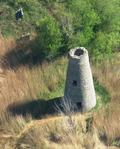 Long Tail Point Lighthouse Built in 1849 near Suamico, Wisconsin, the Long Tail Point Lighthouse was discontinued in 1859 because the government thought it would topple or sink. Over time, two separate lighthouses served as its replacement, but neither of them stand today. At one time the government hired someone to tear down the remains of the lighthouse, but after reviewing the situation, he decided it would be too much work. The lighthouse is now within the boundaries of the Long Tail Unit of the Green Bay West Shore Wildlife Park. It is improbable that the lighthouse will ever be saved and it stands today as an historical ruin that will eventually collapse.  Minnesota Point Lighthouse & Duluth Buoy Depot Built in 1856 in Duluth, Minnesota, the lighthouse served until the late 1800s when the government abandoned the lighthouse in favor of the nearby Wisconsin Point Lighthouse, which is also known as the Superior Harbor Entry South Breakwater Lighthouse in Superior, Wisconsin.  In 1902 the Lighthouse Service built the Duluth Buoy Depot on the site, which was also later abandoned and, like the lighthouse, the Buoy Depot buildings are also in ruins. The Minnesota Point Lighthouse has the distinction of being the only lighthouse to serve on the longest fresh water sand bar in the world and guarded the area for the twin ports of Duluth, Minnesota and Superior, Wisconsin. The prognosis for restoring the Minnesota Point Lighthouse is extremely poor, but it could easily be preserved as a historical ruin; otherwise it will eventually collapse. Additionally, the old buildings of the Duluth Buoy Depot could also be saved and opened as an interpretative center, but without anyone who cares, that is unlikely to happen.  Mobile Point Range Rear Lighthouse Built in 1873 at the entrance to Mobile Bay, Alabama, the lighthouse, which once stood at Fort Morgan, is now disassembled and remains in unprotected storage, rusting away and in deplorable condition. Unless the State of Alabama steps forward now, the prognosis for saving this lighthouse is poor.  Morris Island Lighthouse For all practical purposes the 1876 Morris Island Lighthouse, off the coast of Charleston, SC, has been endangered since 1948 when erosion washed away the island causing the lighthouse to be surrounded by water. In the last few years, Save the Light, Inc. has done an amazing if not miraculous job of rescuing the lighthouse from the brink of collapse. However, the lighthouse tower still needs to be restored, which in itself will be a monumental task. However, thanks to Save the Light and the people of Charleston, the long term outlook for this lighthouse is excellent. (Photograph by Lynn Lapponese.) 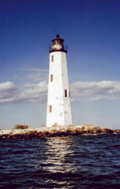 New Point Comfort Lighthouse Built in 1806 at the entrance to the Mobjak Bay in the Chesapeake Bay near Bavon, Virginia, the lighthouse was automated in 1930 and abandoned in 1963. Restoration work was done in the late 1970s, but the tower is now threatened by erosion and again needs additional restoration work. Recently, a grant was obtained to stabilize the island by building a massive wall of boulders around the island. The prognosis for saving this lighthouse is excellent. (Photo by Deb Weissler.)
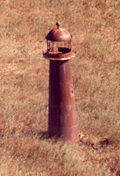 Pass A L'Outre Lighthouse Established in 1855 in what is now the Delta National Wildlife Refuge in Louisiana, the lighthouse station was abandoned in 1930. Over time, the 85-foot tower, which is all that is left of the light station, has sunk in the mud to a height of 50 feet. It is doubtful that this lighthouse will be saved and the day will come when it is gone. 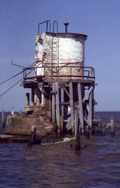 Pass Manchac Lighthouse Built in 1857 in Pass Manchac between Lakes Maurepas and Ponchartrain, Ponchatoula, Louisiana, the lighthouse was de-staffed in 1941 and in 1952 the keeper's dwelling was demolished. Suffering from erosion, the Lake Maurepas Society has installed pilings around the lighthouse to prevent it from toppling. The lantern room is in storage awaiting restoration. A significant amount of money has been raised. The prognosis for saving the lighthouse is fair. (Photograph by Brian LeBourgeois.) 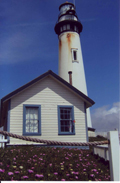 Pigeon Point Lighthouse Built in 1872 at the southern approach to San Francisco Bay near Pascadero, California, the lighthouse has been closed to the public. In 2001 two large sections of brick and an iron cornice broke away from the 115 tower. Since then, the lighthouse restoration, which has been estimated will cost millions, has been tied up in bureaucratic red tape. However, the long term goal for restoration is good. (Photo by Diane Herrick.) 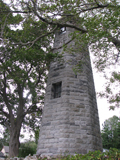 Pointe Aux Roches Lighthouse Established on Lake Champlain in Clinton County at Beekmantown, NY in 1858, it is also known as the Pointe au Roche Lighthouse. In the 1930s when the station was automated, the keeper's house was sold into private ownership. In 1989 the Coast Guard abandoned the tower and it has since fallen into a state of disrepair and a cornice has fallen off. Additionally, the tower is also threatened by erosion. Although there has been some local interest in saving the tower, apparently nothing has progressed and the fate of this tower is questionable.  Poverty Island Lighthouse Located on an island in northwest Lake Michigan near the community of Fairport, the 1874 tower was abandoned by the Coast Guard in 1957. Neglect, vandalism, and time have finally taken their toll on the lighthouse station. The assistant keeper's house shown here to the left has now crumbled, and the roof on the main house is ready to collapse. It appears that the historic light station is doomed. However, if enough people start an ongoing protest, the Poverty Island Lighthouse could and should become a rallying point for lighthouse preservationists.  Price's Creek Lighthouse Built in 1849 near Southport, North Carolina, it is amazing that this lighthouse is still standing. The lighthouse and the property that it sits on are owned by Archer Daniels Midland Co. (ADM). It's deplorable that a company with nearly $70 billion in annual sales has not done anything to restore this lighthouse. Unless ADM steps forward, this lighthouse will eventually be lost. (Photograph by Bob and Sandra Shanklin, The Lighthouse People.) 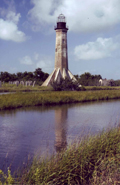 Sabine Pass Lighthouse Built in 1856, the lighthouse was discontinued in 1952 and has suffered from vandalism and neglect. Over the years, numerous attempts were started to restore the lighthouse, but all failed because of a lack of funds. A fire destroyed most of the buildings at the site. Louisiana Preservation Alliance declared the lighthouse as one of the Ten Most Endangered Historic Sites in Louisiana. Since 2001 the Cameron Preservation Alliance has slowly been raising funds to save the lighthouse. Because there has been ongoing interest, we believe the prognosis for saving this lighthouse is fair. (Photo by Francine Dollinger.)  Sand Island Lighthouse Built in 1873 on a sand island a few miles from Dauphin Island, Alabama, the lighthouse has been inactive since 1933. Recently, new rip-rap has been installed around the lighthouse and restoration will take place when the funds are secured. Provided the lighthouse does not take a direct hit from a hurricane and money can be raised, the long term outlook for this lighthouse is positive. (Photograpgh by Bob & Sandra Shanklin, "The Lighthouse People.") 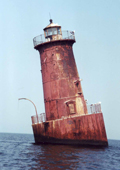 Sharp's Island Lighthouse Built in 1882 near Tilghman Island at the east side of the Chesapeake Bay in Maryland, the lighthouse has been leaning since the 1970s. Sold at auction in 2008 for $80,000, the lighthouse is now privately owned. Since it will take an immense of money to save this lighthouse, we believe its long range prognosis is poor. (Photo by Karen Harshman.)  Ship Shoal Lighthouse Built in 1858 south of Grand Isle in the Gulf of Mexico near Berwick, Louisiana, the Ship Shoal Lighthouse was officially abandoned in 1972. Since 1929, the tower had been leaning to one side. For a number of years there has been talk of dismantling the lighthouse and moving it to the Town of Berwick where it would be restored and reassembled as the town did in 1987 with the Southwest Reef Lighthouse. However, this may be a difficult undertaking in these economic times. The prognosis for saving this lighthouse is very poor.  Southwest Pass Lighthouse Built in 1873 at the entrance to the Mississippi River near Venice, Louisiana, the lighthouse was discontinued in the mid 1900s. There has never been any interest is saving this rusting hulk and the day may come when it is gone forever.  Tillamook Rock Lighthouse Built in 1831 on a large rock off the coast of Seaside, Oregon, the lighthouse was deactivated in 1957. Sold at auction, it has since had several owners. A group called Eternity at Sea started a facility for urns for the repository for ashes at the lighthouse. They reportedly gutted the interior for this purpose. Unfortunately, no photos of what they have done at the lighthouse have ever been published. Access to the lighthouse is only by helicopter; however it was reported in various places that two urns were stolen and that the lighthouse had been vandalized and it is deteriorating from the elements. The future is very dubious and can be rated between uncertain to poor. (Aerial photo in 2005 by Elinor DeWire.) 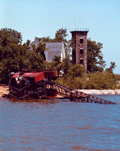 Turtle Island Lighthouse Built in 1866 on an island in Lake Erie near the Michigan and Ohio state line, northeast of the mouth of the Maumee River, the lighthouse was abandoned when it was replaced by the Toledo Harbor Lighthouse. It was auctioned off and over the years there have been numerous attempts to save and revive the island and the lighthouse. These were mostly unsuccessful because of legal disputes, weather and financial problems. Although it is certainly possible to save the lighthouse, its future is very dim.  Waugoshance Lighthouse Established in 1851 to mark the Waugoshance Shoal in the Straits of Mackinac in northern Lake Michigan, this magnificent tower was discontinued and abandoned by the government in 1912. The Waugoshance Lighthouse Preservation Society is trying to raise money to save it. However, with the protective pier long gone, the limestone blocks which serve as the foundation for the tower are now exposed to the weather and the winter ice. A few of these blocks have already shifted and more ice floes could cause others to shift and compromise the entire structure. It will take “megabucks� to save the lighthouse. Although there is a valiant effort underway to raise money, the best alternative will be to save the structure as an historical ruin. (Photo by Larry A. Jacobs.) 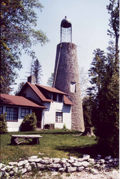 Baileys Harbor Lantern Room Bailey's Harbor Lighthouse, also known as Old Bailey's Harbor Lighthouse, was built in 1853 on Lighthouse Island in Door County, Wisconsin in 1853. By 1869 it had outlived its usefulness and was discontinued. The privately owned lighthouse tower and keeper's house are well taken care of and in good condition. However, the lantern room, one of few remaining bird-cage style lantern rooms remaining on Lake Michigan, is in a precarious condition and quite possibly in danger of being lost forever. Because of this, we have listed the lantern room only on the Doomsday List.(Copyright photo courtesy of Wayne Sapulski.)
If you are not a subscriber, please subscribe today. Click here. |


